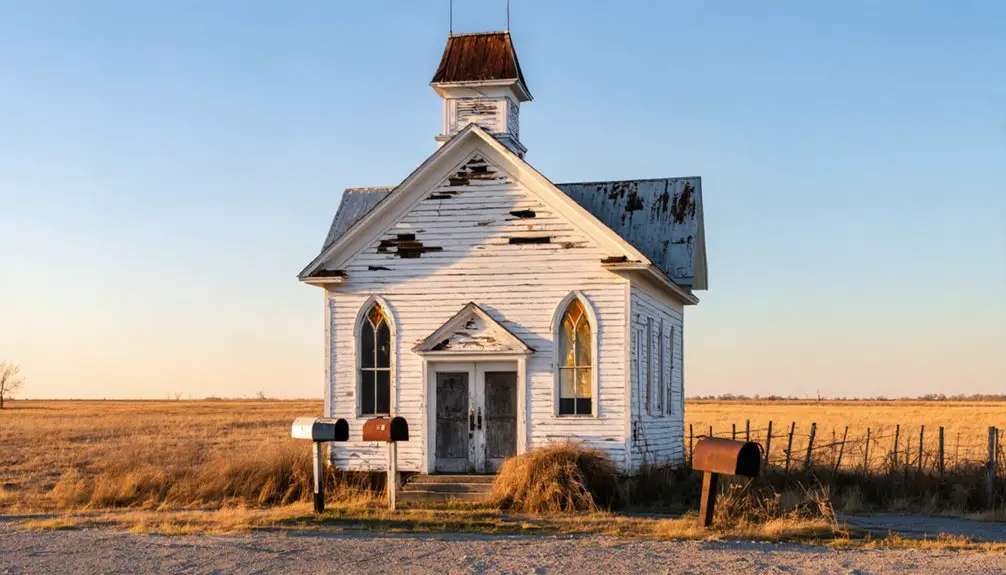You’ll find Elmo, Kansas as a symbol of prairie settlement life, having peaked at 225 residents in 1910. The town’s stone bank building, constructed in 1898, anchored local commerce with monthly deposits reaching $10,000. When the Missouri Pacific Railroad bypassed Elmo for Banner City in 1887, it marked the beginning of decline. Today, scattered ruins and abandoned structures tell a deeper story of agricultural heritage and frontier ambition.
Key Takeaways
- Elmo was a prairie settlement in Dickinson County, Kansas that peaked at 225 residents in 1910 before declining into a ghost town.
- The Missouri Pacific Railroad’s bypass of Elmo for Banner City in 1887 marked the beginning of the town’s economic decline.
- A stone bank building from 1898 and abandoned industrial structures remain as physical remnants of Elmo’s once-thriving community.
- The closure of the post office in 1966 and removal of railroad service in the 1990s contributed to Elmo’s near-complete abandonment.
- Scattered homes and ruins of an old church are all that remain of this former agricultural community in present-day Kansas.
The Rise of a Prairie Settlement
As pioneers pushed westward across Kansas in the late 19th century, Elmo emerged as a quintessential prairie settlement in Dickinson County.
You’ll find its origins followed typical settlement patterns of the post-Civil War frontier, where hardy settlers established roots amid the vast Kansas plains. Economic downturns like the Dust Bowl era devastated many similar farming communities across the Great Plains.
Like St. Elmo in Colorado, which reached its peak with a population of over 2,000 residents in 1890, the Kansas town drew settlers seeking opportunities in America’s expanding frontier.
Banking and Commerce in Early 1900s
The bustling commerce of early 1900s Elmo centered around its stone bank building, constructed in 1898, which anchored the town’s financial activities.
You’d find banking innovations like money orders and agricultural loans supporting the town’s growth, with monthly deposits reaching up to $10,000 – comparable to other Kansas farming communities of the era.
The community impact of this financial hub rippled through Main Street’s diverse businesses.
A thriving financial center creates waves of prosperity, energizing local commerce and connecting businesses across Main Street’s storefronts.
Like many towns documented by the Kansas Historical Society, Elmo’s financial district represented the economic vitality of small-town America before widespread decline began after WWII.
You could visit well-stocked general stores, hardware shops, and drug stores, while farmers traded at the grain elevator near the Missouri Pacific Railroad station.
In 1910, the town reached its peak with a population of 225 and maintained a strong business presence.
The bank’s presence enabled local dealerships to offer tractors and automobiles, while the post office’s rural routes expanded commerce beyond town limits.
This financial ecosystem helped Elmo thrive as a regional agricultural center through the early 1900s.
Agricultural Legacy and Infrastructure
Sprawling farmland between Elmo and Carlton formed the backbone of this Kansas community’s agricultural might. You’d find traditional farming techniques in practice, with farmers rotating their wheat, corn, and soybean crops across the fertile soil. Technological advancements gradually reduced the need for manual farm labor over time.
The town’s prominent grain elevator served as a hub for storing and shipping these harvests, driving the local economy. Generations of farmers, including those who provided water for railroad workers, helped build the foundation of this agricultural community.
If you’d visited during Elmo’s heyday, you’d have seen a landscape dotted with barns, silos, and the steady movement of farm equipment. The economic impact of agriculture reached far beyond the fields, supporting local businesses and shaping community life.
While many of these structures now stand abandoned, they’re silent testimonies to an era when farming families were the lifeblood of small-town Kansas, their legacy preserved in the weathered buildings and community memories.
Transportation Networks and Trade Routes
Elmo’s economic fate was heavily influenced by the Missouri Pacific Railroad‘s decision to bypass the town due to its sloping terrain, instead establishing a station in nearby Banner City around 1887.
You’ll find that this railroad bypass forced Elmo to rely on local roads connecting to railheads, greatly impacting its ability to participate in the region’s agricultural shipping networks.
While the town maintained some commercial liveliness through road connections to larger hubs like Abilene, 16 miles north, the lack of direct rail access ultimately contributed to its decline and eventual ghost town status. Other Kansas towns like Kent experienced similar challenges, though Kent briefly gained recognition as a stop during the Scott Special train record attempt in 1905.
Historical Railroad Connections
While seeking to establish a thriving agricultural hub in Dickinson County, Elmo faced a pivotal setback when the Missouri Pacific Railroad bypassed the town due to its sloping terrain, opting instead to place its station one mile away in Banner City around 1887.
Despite lacking direct rail access, you’ll find that Elmo adapted by developing strong trade dynamics through Banner City’s station. Similar to how Tickle Me Elmo became a cultural phenomenon in 1996, the town experienced its own peak of prosperity. By 1910, with a population of 225, the town maintained a grain elevator and various businesses to support agricultural commerce. Located in Banner Township, Elmo remained an important local agricultural center until its decline.
The railroad impact proved significant – farmers transported their goods by wagon to Banner City for rail shipment. However, when the Missouri Pacific line was removed in the 1990s, following the post office’s closure in 1966, Elmo’s role as a trade center diminished, leading to its eventual near-abandonment.
Highway Junction Development
The lack of major highway junctions near Elmo compounded the challenges created by its railroad bypass.
While you’d find the town positioned 16 miles south of Abilene, a significant regional hub, highway planning decisions consistently favored other locations. The economic implications were severe – without direct access to major transport arteries, Elmo’s potential for growth remained severely limited.
Local roads did connect Elmo to surrounding agricultural areas, allowing some trade to persist. Like ghost town exploration, visitors can now wander the remaining structures that hint at the town’s trading past.
However, as transportation networks evolved from rail to highway systems in the late 20th century, Elmo’s isolation intensified. The removal of rail service in the 1990s dealt another blow, leaving the town increasingly disconnected from essential freight routes.
You’ll now find only scattered remnants of infrastructure, including a grain elevator, as evidence of Elmo’s former role in regional commerce.
The Path to Abandonment

From its early days as a promising Kansas settlement, Elmo’s path toward abandonment began when the Missouri Pacific Railroad bypassed the original townsite due to unfavorable terrain.
Despite showing remarkable community resilience by relocating to Banner City in 1887, you’ll find this move marked the beginning of gradual economic shifts that would ultimately seal the town’s fate.
Though Elmo reached its peak in 1910 with 225 residents, a bank, and various businesses, the following decades brought steady decline.
The post office’s closure in 1966 signaled the community’s dwindling significance, while the railroad’s removal in the 1990s dealt the final blow.
Today, you’ll see only scattered homes, an abandoned industrial building, and the ruins of an old church – silent witnesses to a once-thriving prairie town’s slow fade into history.
Preserving Elmo’s Historical Memory
Despite Elmo’s physical decline, efforts to preserve its historical memory continue through dedicated documentation and regional storytelling.
You’ll find the town’s story woven into Dickinson County‘s broader historical narrative, particularly through local archives and educational programs. Historical documentation primarily relies on photographic galleries and written records, including Frank W. Blackmar’s extensive works and the “Legends of Kansas” collection.
While Elmo lacks a dedicated museum or formal preservation society, nearby communities like Banner City help maintain its legacy through county-wide projects and annual events.
Local storytelling thrives in schools and libraries, where you can discover how this once-thriving community of 225 residents shaped the region’s agricultural and railroad heritage before its post office closure in 1966.
Frequently Asked Questions
Are There Any Surviving Buildings or Structures Still Standing in Elmo Today?
You’ll find scattered homes, an abandoned industrial building, a former oil tank, and a church still standing, though there’s minimal historical preservation of these deteriorating structures.
What Happened to the Residents Who Lived in Elmo During Its Decline?
You’ll find most residents moved to larger cities like Abilene during the economic downturn of the mid-1900s. The residential migration followed closures of the post office and railroad, forcing locals to seek opportunities elsewhere.
Were There Any Schools or Churches Established in Elmo?
You’ll find that Elmo’s school history included a one-room schoolhouse with a gym, while its church significance centered on Catholic and Methodist churches, including St. Columba, serving the community.
What Natural Disasters or Events Contributed to Elmo’s Abandonment?
Multiple tornados struck the region, destroying over 75% of local structures. You’ll find these disasters, combined with flood damage and ongoing economic decline, accelerated the town’s abandonment throughout the mid-1900s.
Did Any Notable Historical Figures or Events Originate From Elmo?
You won’t find any nationally recognized Notable Residents or major Historical Events from this small farming town. Its significance came from being a typical agricultural shipping hub in early 1900s Kansas.
References
- https://www.tripadvisor.com/Attraction_Review-g33562-d196118-Reviews-St_Elmo-Nathrop_Chaffee_County_Colorado.html
- https://www.youtube.com/watch?v=OyBXD18P_j4
- https://legendsofkansas.com/elmo-kansas/
- https://en.wikipedia.org/wiki/Elmo
- https://legendsofkansas.com/dickinson-county-extinct-towns/
- https://www.legendsofamerica.com/co-stelmo/
- https://www.geotab.com/ghost-towns/
- http://kansasghosttowns.blogspot.com/2012/01/elmo-kansas-dickinson-county-dead-town.html
- https://freepages.rootsweb.com/~gtusa/history/usa/ks.htm
- http://www.kansastowns.us/hopehist.html



